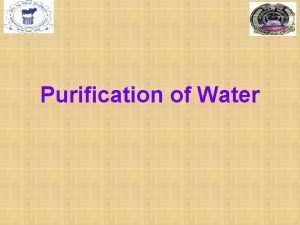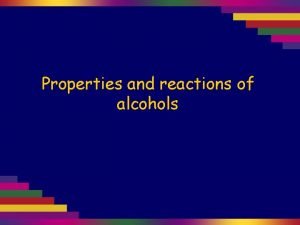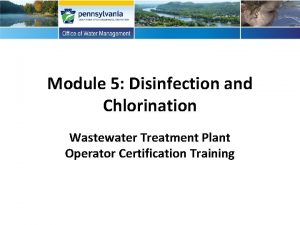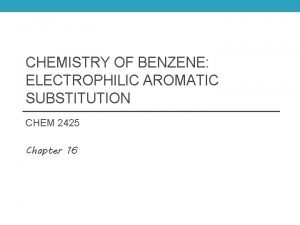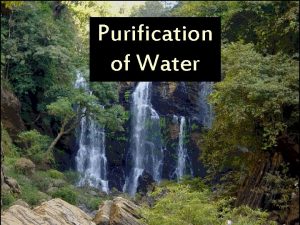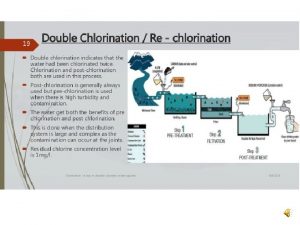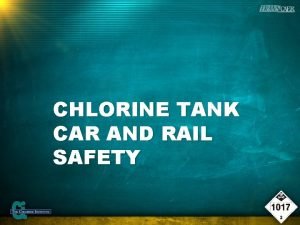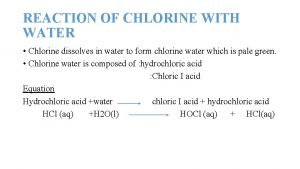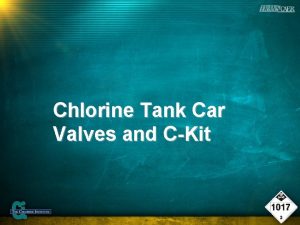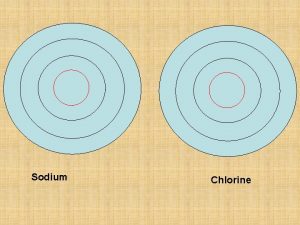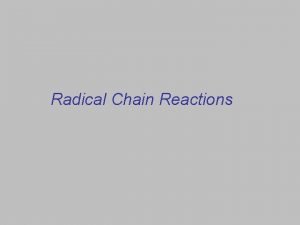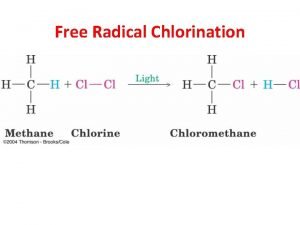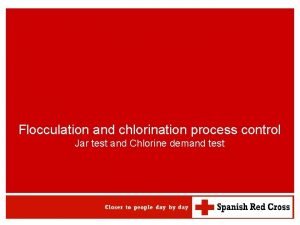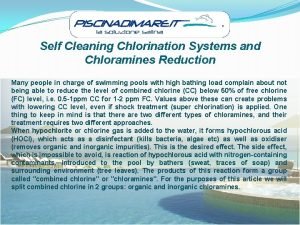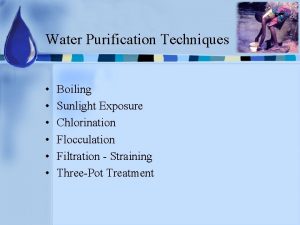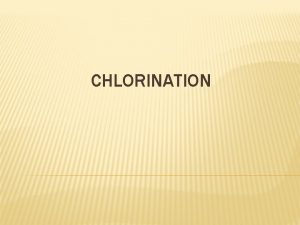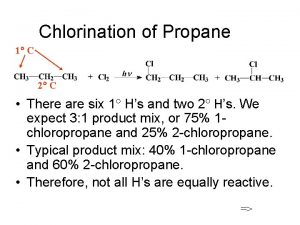CHLORINATION Why We Use Chlorine Chlorine is the


















- Slides: 18

CHLORINATION


Why We Use Chlorine? Chlorine is the eleventh most common element in the earth's crust. Chlorine is one of the most commonly used disinfectants for water disinfection. Chlorine can be applied for the deactivation of most microorganisms and it is relatively cheap. .

Properties of Chlorine Boiling point: -34 Degree Density is higher than air.

• Chlorine was first used in the U. S. as a major disinfectant in 1908 in Jersey City, New Jersey Chlorine use became more and more common in the following decades, and by 1995 about 64% of all community water systems in the United States used chlorine to disinfect their water

Applications of chlorine • Chlorine has been used for applications, such as the deactivation of pathogens in drinking water, swimming pool water and wastewater, for the disinfection of household areas and for textile bleaching, for more than two hundred years. • The German Army first used chlorine gas cylinders in April 1915 against the French

Chlorine Delivery • Chlorine is a very reactive and corrosive gas. When it is transported, stored or used, safety precautions must be taken. In Holland for example, chlorine is transported in separate chlorine trains.


How does chlorine disinfection work? Chlorine kills pathogens such as bacteria and viruses by breaking the chemical bonds in their molecules. Disinfectants that are used for this purpose consist of chlorine compounds which can exchange atoms with other compounds, such as enzymes in bacteria and other cells. When enzymes come in contact with chlorine, one or more of the hydrogen atoms in the molecule are replaced by chlorine. This causes the entire molecule to change shape or fall apart. When enzymes do not function properly, a cell or bacterium will die. When chlorine is added to water, underchloric acids form: Cl 2 + H 2 O -> HOCl + H+ + Cl. Depending on the p. H value, underchloric acid partly expires to hypochlorite ions: Cl 2 + 2 H 2 O -> HOCl + H 3 O + Cl. HOCl + H 2 O -> H 3 O+ + OCl. This falls apart to chlorine and oxygen atoms: OCl- -> Cl- + O

How It Works When chlorine is poured into water it breaks into several chemical compounds, including hypochlorous acid and hypochlorite ion. The combination of hypochlorous acid and hypochlorite ion is a reaction called "free chlorine. " Both of these substances attack the microorganisms and bacteria in the water by going after the lipids in their cell walls and destroying the enzymes. As they destroy the structure inside the cells the chemical compounds leave the bacteria cells oxidized, which kills the cell, leaving it harmless.


Chlorine feeder Tablet

Disinfection times E. coli 0157 H 7 bacterium < 1 minute Hepatitis A virus about 16 minutes Giardia parasite about 45 minutes Cryptosporidium about 9600 minutes (6, 7 days)

How much chlorine should we use? • According to international standards, free chlorine should be between 1. 0 -3. 0 mg / L.

Residual Protection • Residual protection; after the water is given to the water system as a result of microbiological contamination in water disinfectant to prevent the growth of microorganisms that can pass into the substance is considered.

SUPERCHLORINATION • Superchlorination is a water treatment process in which the addition of excess amounts of chlorine to a water supply speed chemical reactions or insure disinfection within a short contact time. • Superchlorination is most commonly used when water has very high bacteria content and generally comes from river sources or where some form of pollution has occurred. It is also an important part of swimming pool maintenance because it keeps chlorine content at the right level to effectively kill off bacteria and other contaminants. • Superchlorination is also known as shocking.

What are the health effects of chlorine? The reaction of the human body to chlorine depends on the concentration of chlorine present in air, and on the duration and frequency of exposure. Effects also depend on the health of an individual and the environmental conditions during exposure. When small amounts of chlorine are breathed in during short time periods, this can affect the respirational system. Effects vary from coughing and chest pains, to fluid accumulation in the lungs. Chlorine can also cause skin and eye irritations. These effects do not take place under natural conditions. When chlorine enters the body it is not very persistent, because of its reactivity. Chlorine is much denser than air, causing it to form a toxic fume above the soil. Chlorine gas affects the mucous membrane (nose, throat, eyes). Chlorine is toxic to mucous membranes because it dissolves them, causing the chlorine gas to end up in the blood vessels. When chlorine gas is breathed in the lungs fill up with fluid, causing a person to sort of drown.

Thank you…
 Hey bye bye
Hey bye bye Double pot method of disinfection
Double pot method of disinfection Lucas' reagent
Lucas' reagent Breakpoint chlorination definition
Breakpoint chlorination definition Principles of chlorination of water
Principles of chlorination of water Xxchx
Xxchx Friedel crafts acylation of benzene
Friedel crafts acylation of benzene Double pot method of chlorination
Double pot method of chlorination Dont ask why why why
Dont ask why why why Hình ảnh bộ gõ cơ thể búng tay
Hình ảnh bộ gõ cơ thể búng tay Frameset trong html5
Frameset trong html5 Bổ thể
Bổ thể Tỉ lệ cơ thể trẻ em
Tỉ lệ cơ thể trẻ em Gấu đi như thế nào
Gấu đi như thế nào Chụp tư thế worms-breton
Chụp tư thế worms-breton Bài hát chúa yêu trần thế alleluia
Bài hát chúa yêu trần thế alleluia Các môn thể thao bắt đầu bằng từ đua
Các môn thể thao bắt đầu bằng từ đua Thế nào là hệ số cao nhất
Thế nào là hệ số cao nhất Các châu lục và đại dương trên thế giới
Các châu lục và đại dương trên thế giới

